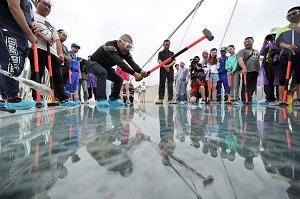Chinese engineers have unveiled the world's longest and highest glass-bottom bridge in the Zhangjiajie Grand Canyon. The bridge serves as a skywalk from one side of the canyon to the other. And it's very strong. So strong that they decided to hold an event to show off its strength that included a journalist taking a sledgehammer to the glass walkway. To add to the anxiety of standing on a glass bridge, the engineers allowed a car to be driven on the glass surface.
The glass bridge is suspended 300 metres (984 feet) in the air and 430 metres (1,411 feet) long and 20 feet wide, suspended in Zhangjiajie's National Park. Chief engineer of the project, Ma Liang, said: "We use a  method of gluing together every panel to tighten the area between them. The thickness of every glass panel is 1.5 centimetres." They then took the Volvo XC90 SUV to the bridge with 11 passengers inside of it and drove it across the bridge, amounting to two tons. Some of the glass panels did shatter under the sledgehammering and the car driving over them but the panels are easily replaced. The chief design engineer on the project said that the bridge can withstand up to 100 MPH winds.
method of gluing together every panel to tighten the area between them. The thickness of every glass panel is 1.5 centimetres." They then took the Volvo XC90 SUV to the bridge with 11 passengers inside of it and drove it across the bridge, amounting to two tons. Some of the glass panels did shatter under the sledgehammering and the car driving over them but the panels are easily replaced. The chief design engineer on the project said that the bridge can withstand up to 100 MPH winds.
The bridge can take the weight of 800 people and will be opening in July. It was supposed to be opened in May, however, weather conditions slowed the engineers down. The man behind the design of the bridge was Israeli designer, Haim Dotan. The bridge cost approximately $37.4 million to construct. Dotan said he wanted to build a bridge that was second in beauty to the nature that the area is known for. The film Avatar was filmed in the canyon.
to be opened in May, however, weather conditions slowed the engineers down. The man behind the design of the bridge was Israeli designer, Haim Dotan. The bridge cost approximately $37.4 million to construct. Dotan said he wanted to build a bridge that was second in beauty to the nature that the area is known for. The film Avatar was filmed in the canyon.
